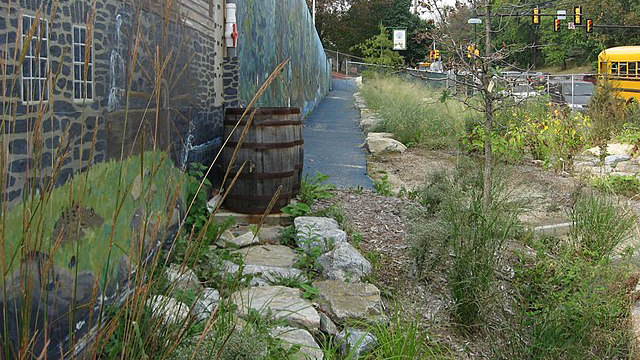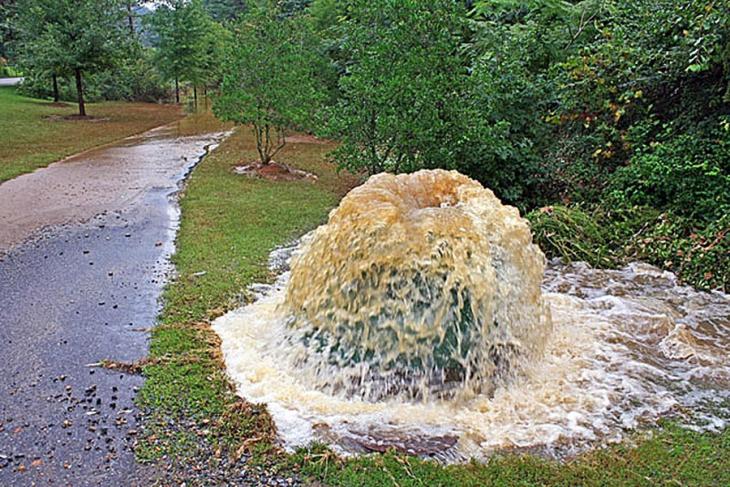
A downloadable version of this lesson is available here:
Green Infrastructure (GI) describes a set of design interventions to better modulate stormwater runoff in cities with high levels of impervious surfaces. These designs include rain gardens, planter boxes, bioswales, urban gardens, and green roofs. These interventions are particularly exigent in cities that experience combined sewer overflow (CSO): when gray infrastructure channels both storm water and waste water in the same system, which in heavy rain events can exceed volume capacities and release untreated sewage into waterways. Several types of GI use biomimicry to reduce storm water volumes by taking advantage of the natural ability of trees and green plantings to slow stormwater flows and absorb rainwater, then release gradually in transpiration. Well-planned GI can also support co-benefits to communities by decreasing the urban heat island effect, improving air and water quality, providing urban wildlife habitat, and enhancing aesthetics in community spaces. Research by Hopkins et al. (2018) examines the considerable growth in city planning and installation of GI following a 2007 U.S. Environmental Protection Agency (EPA) memorandum supporting GI policy and funding, coupled with EPA consent decrees that require cities to remediate their CSO problems. However, research by Hoover et al. (2021) reveals how environmental justice (EJ) considerations are rarely built into city plans for siting GI. This lesson challenges learners to integrate GI hydrology, public policy, and EJ co-benefits.
- Learn about GI histories and planning in specific cities and how well these plans address the many considerations of investing in GI: old CSO infrastructure, habitat, livability, equity, and justice.
- Challenge GI policy planners to consider and integrate EJ priorities in an effort to meet policy goals set by the EPA and redress the gentrification that can accompany GI investments.
- Creatively imagine better integrated GI/EJ policy for specific cities and develop a draft policy white paper to educate the City Council.
(5 min.) Consider this image of a CSO event in Georgia, USA. What are some consequences of our aging gray infrastructure's inability to handle stormwater capacities? List at least three human and three environmental effects of this event. Then, in a 2-min. lightning discussion, consider how these effects may magnify due to retrofitting that increases urban population density and more impactful rainfall events due to climate change.
Green Infrastructure: Urban Stormwater, Policy, and Justice (One 75-minute class; optional extension to two 75-minute classes)
-
As preparation for class, have learners read Hopkins et al. (2018) and Hoover et al. (2021), paying particular attention to the highlighted sections.
DocumentHopkins et al. 2018 – Highlighted.pdf (1.11 MB)DocumentHoover et al. 2021 – Highlighted.pdf (3.28 MB) -
(10 min.) Review the major concepts and trends discussed in the papers using these lesson PPT slides.
Document -
(5 min.) Form small groups of three to four learners each. These groups will cross-reference the two publications to generate a profile of their assigned city in relation to its GI policy and EJ siting histories. Groups will develop integrative GI development plans based on each city’s strengths, needs, and challenges. Cities named in the papers:
- Chicago, IL
- Milwaukee, WI
- New York, NY
- Philadelphia, PA
- Portland, OR
- Washington, DC
-
(20 min.) Groups should begin by compiling information on their assigned city from the papers. Note that policy gaps and inadequacies point to potential correctives or solutions in future planning. For each city, record the following:
Sewer system characteristics (Hopkins Table 1)
Investments in green and gray infrastructure (Hopkins Table 2)
Proportion of gray/green terms used in city planning documents (Hopkins Table 3)
The results of a keyword search of your city within Hopkins et al. that highlight any discussion of it
The city’s proportionate distribution of siting criteria and categories, paying special attention to the purple-scale “SOC” criteria and EJ within that array (Hoover Figure 3)
Proportionate distribution of subcategories within the “SOC” criteria (Hoover Figure 6)
The results of a keyword search of your city within Hoover et al. that highlight any discussion of it and/or its performance in the other metrics in Hoover figures 4-8
-
(15 min.) With this city GI profile compiled, each group is now in a position to evaluate the strengths and gaps in planning, policy, and focus on EJ as part of GI siting criteria. In synthesizing this information, groups should consider:
The complexity of their city’s sewer system (complexity can imply opportunity)
The extent to which the city’s planning includes both GI terms and social/EJ factors
Its status as a “green leader” as described by Hopkins et al. versus any discussion of its social/EJ siting criteria by Hoover et al.
Gaps in knowledge (city demographics, climate change profiles, and opportunities/challenges that may not be discussed in the two papers, etc.) that the group might resolve with online research
Specific initiatives, projects, and case studies in their city that may help the group highlight GI/EJ problems and potential solutions.
-
(20 min.) Now, groups have the opportunity to advise on the city’s best practices in future GI investment, siting, and integration of EJ priorities. They will compose a brief white paper addressed to their city’s council that includes an Introduction, Problem Statement, Proposed Solutions, and Conclusion. This white paper should integrate: 1) proactive resilience to climate change with an emphasis on urban greening and ecosystem services of GI; 2) equity and justice targeting economic, cultural, and infrastructural benefits to historically marginalized communities. By the end of the 75-minute period, groups should have a rough draft of this document to exchange among members.
-
As homework, have groups collectively revise their white paper and post a groomed draft on the class discussion board for all learners to view. Instructors might require learners to review one or two other plans and provide comments to those groups.
-
Optional Extension: In the next class session, with the groomed white papers posted, the whole class may now review the series of six city profiles, and discuss each one in some depth (about 10 minutes each). In this full group session, learners should observe best practices in both GI and EJ implementation, noting regional, hydrological, and demographic similarities and differences. As each city’s white paper is profiled, compile a list of challenges and opportunities across the board. For the final 15 minutes, compile a summary policy document that might be useful to city planners nationwide in synthesizing GI with EJ.
-
Green Infrastructure and Issues in Managing Urban Stormwater
Green infrastructure systems use or mimic natural processes to infiltrate, evapotranspire, or reuse stormwater runoff on the site where it is generated. In 2012, EPA issued an integrated permitting and planning framework for water infrastructure projects. The intention of the framework is to provide communities with flexibility to prioritize needed water infrastructure investments, identify green infrastructure opportunities, and work with communities to refine how the agency determines when an infrastructure project is affordable.
Copeland, C. (2014). Green Infrastructure and Issues in Managing Urban Stormwater. Congressional Research Service. https://nationalaglawcenter.org/wp-content/uploads/assets/crs/R43131.pdf
-
Unequal Protection Revisited: Planning for Environmental Justice, Hazard Vulnerability, and Critical Infrastructure in Communities of Color
This review demonstrates how fundamental principles of EJ can bolster those of social vulnerability with a focus on stormwater systems and flood risks. Neighborhoods are not inherently vulnerable, but they occupy built environments that are systematically sequestered, neglected, and underserved. Social processes and larger planning and development patterns shaped by power and privilege create areas of both prosperity and disadvantage. These outcomes are brought about specifically by early racial zoning, segregation, legalized redlining, and ultimately the isolation of racial minorities that have led to diminished tax bases and built environments in disrepair. Thus, infrastructural robustness and resilience at the neighborhood level result from human decisions and social ideologies of environmental racism and classism.
Hendricks, M., & Van Zandt, S. (2021). Unequal Protection Revisited: Planning for Environmental Justice, Hazard Vulnerability, and Critical Infrastructure in Communities of Color. Environmental Justice, 14(2), 87-97. https://doi.org/10.1089/env.2020.0054
-
NYC Green Infrastructure
This 9-minute video summarizes New York City (NYC)’s progress in addressing CSOs and installing GI to improve the water in New York Harbor to a better quality than it’s seen in the last century. The video highlights the efforts to use city-owned properties including schools, colleges, and low-income housing, as sites for green infrastructure projects.
NYC Water. (2013, August 2). NYC Green Infrastructure [Video]. YouTube. https://www.youtube.com/watch?v=zrhw2cMTpJs
